A Smart Campus’ Digital Twin for Sustainable Comfort Monitoring
Abstract
1. Introduction
1.1. Research Motivation and Scope
1.2. The Importance of the University in the Promotion of Sustainability
1.3. The Statement for Our Smart Campus Comfort Challenge
1.4. Framework-Based Methodology
1.5. IoT Platforms
2. A Proposal for Smart Campus’ Metrics to Obtain a Digital Twin Model
2.1. Comfort Modeling
2.1.1. Thermal Comfort (TC)
2.1.2. Acoustic Comfort (AC)
2.1.3. Visual Comfort (VC)
2.1.4. Indoor Air Quality (IAQ)
2.2. Energy Efficiency Monitoring
- Design of an energy-efficient building: the implementation of a whole-building system approach to new construction is the most efficient way to achieve an energy-efficient building (see Figure 4).
- Weather usage: the design should take into consideration the building orientation. The way a structure is situated on a site and the placement of its windows, rooflines, and other architectural features is critical for efficiency. Weather data could be incorporated by outdoor sensor agents or by using a public Application Programming Interface (e.g., Meteostat’s API offers historical and daily weather data from anywhere [90]).
- Ventilation: in a traditional building that uses natural ventilation or extract ventilation, 20 to 40 percent of energy consumed for heating is caused by ventilation.
- Lighting: the decision to install (1) IoT sensors such as timers and photocells that turn lights off when not in use and (2) dimmers, when used to lower light levels are good decisions to save money and energy. Light over ethernet or digital addressable lighting interfaces are smart solutions that make luminaries controllable. These methods are applied with light-emitting diode (LED) technology and allow a total control and monitoring of the whole building’s luminaries [91,92].
- Heating: this concept is the largest energy expense in educational and commercial buildings. The incorporation of energy-efficient and real-time measures into a building’s heating and cooling systems is essential to create an energy-efficient accurate model of the current behavior inside the digital model. In terms of heating, a programmable or smart thermostat is one of the best options to work hand in hand with the wise module. When you install a programmable thermostat, it is easier to eliminate wasteful energy use from heating and cooling without upgrading the HVAC system or sacrificing any comfort [93].
- Monitoring: an energy modeling software is an effective way to bridge the physical and the virtual world. The digital twin could also integrate historical data from past usage to factor into its digital model. Thus, data must be transmitted seamlessly, allowing the virtual entity to exist simultaneously with the physical entity [94,95].
3. The Digital Twin Deployment
3.1. The Building Premises Modeling
- A common social meeting point where people can debate, show, and even try out any idea that has been conceived during the innovation process. Ideas can later be tried out in the design and testing processes.
- Creativity room: spaces designated to fomenting creativity and information exchanges and where challenges are born into a creative and imaginative environment. These spaces can be used for structured activities, but also to facilitate an idea flow, which can be used to set off new innovation and research processes.
- Maker space: workspace designed to provide tools to develop projects for the group of researchers from the areas of architecture, management and engineering, together with designers, students, inventors, and entrepreneurs.
- City lab: space for the assembly and testing of technologies that have been developed. This is the showroom where the final products of projects are displayed, which promotes learning through overcoming challenges and is now being used all over our campus. This new laboratory will enable students to go further than case-studies, using new research and transfer techniques, with systemized processes to face tomorrow’s challenges.
- BIM or building information modeling is a process, not an application, to create and manage information on a construction project across the project’s lifecycle. It refers to a virtual model that contains a data-rich, object-oriented, intelligent and parametric digital representation of facilities [99], coinciding with the main benefits over conventional 3D computer-aided design (CAD) [100]. Thus, BIM enables those who interact with the building to predict performance appearance and cost, resulting in a greater whole life value for the asset.
- Revit is a modeling software to simulate, visualize, and collaborate in order to capitalize on the advantages of the interconnected data within a BIM model [98]. When one piece of datum changes in one view, it is updated in all other views automatically by Revit because each view is displaying the same data.
- Dynamo Revit is a graphical programming interface that enables the customization of the building information workflow [98]. Dynamo is an open-source visual programming platform for designers and has been installed as part of Revit since 2020, and hence it allows designers to set up automated computing processes or platforms in order to correlate processed data to structural and geometric models.
3.2. High-Level Design For The Sensing Level
3.2.1. Data Collection
3.2.2. Data Storage
3.2.3. IEQ and Energy-Efficient Calculations
3.2.4. Comfort Visualization
4. Discussion and Conclusions
- Sensing level is defined as the ability to automatically identify and become aware of a phenomenon and its impact (positive or negative) by using sensors.
- The inferred level is defined as the ability to make logical conclusions based on sensed data (e.g., activate HVAC, turn off lights, and recommend administrators to take certain pro-active countermeasures).
- Further work is required to consolidate in our digital twin campus the adaptation, learning, anticipation, and self-organization smartness levels [97].
- This paper proposes a digital twin modeling procedure that merges well-known approaches used in SC to integrate a set of advanced intelligent features: the use of technology for a digital SC by using an IoT network and cloud computing to transform university spaces into information sources for intelligent decision-making processes. SC will adopt the technological paradigm in order to support multiple tasks in multi-functional buildings (teaching, research, management, and services) and include different users (students, researchers, guests, etc.). Our proposal is to develop the SC through the efficient use of resources, thereby reducing operational costs and making life more comfortable.
- Our contributions tackle three intelligence domains that should be equipped with various capabilities [8,52]. (1) Green campus, in line with the issue of climate change, which includes the intelligent energy consumption and the implementation of sensor technology for accurate reporting. (2) Healthy campus, to monitor and promote the level of comfort by tracking and recording the status of the campus activity and (3) real-time facility management, which includes the facilities, infrastructures and people (staff, students and visitors).
- The proposed SC concept is not limited to supporting smart learning processes and can also support other aspects of campus life (the comfort of the academy community understood as a quality metric).
- In the developed model, all the smart campus devices, the energy consumption performance, and the comfort evaluation dashboard can be accessed by the stakeholders through the BIM platform. This middleware facilitates the interoperability and the co-working between engineering and architecture staff by promoting an interdisciplinary task force. We envisage that if sustainable policies have to be defined, an interdisciplinary team could easily cope with the identification of patterns and the suitability assessment of the proposed improvements.
- The main goal of our ongoing research project is to develop SC concepts, digital twin, and complex adaptive systems, and identify the main distinctive characteristics, modules, and technologies of a multi-disciplinary SC. The aim is to improve sustainability beyond that of a traditional campus with heterogeneous learning activities.
Author Contributions
Funding
Acknowledgments
Conflicts of Interest
Abbreviations
| AC | acoustic comfort |
| AEC | architecture, engineering and construction |
| AMQP | advanced message queuing protocol |
| ATHIKA | Advanced Training in Health Innovation Knowledge Alliance |
| ASHRAE | American Society of Heating, Refrigerating and Air-Conditioning Engineers |
| AWS | amazon web services |
| API | application programming interface |
| BIM | building information modeling |
| BUS | Building Use Studies Ltd. |
| CAD | computer-aided design |
| CBE | Center for the Built Environment |
| CEN | European Committee for Standardization |
| CIE | International Commission on Illumination |
| CoAP | constrained application protocol |
| CAS | complex adaptive systems |
| ERDF | European Regional Development Fund |
| HTTP | hypertext transfer protocol |
| HVAC | heating, ventilation, and air conditioning |
| IaaS | infrastructure as a service |
| IAQ | indoor air quality |
| ICTs | information and communication technologies |
| IEQ | indoor environmental quality |
| IES/ANSI | Illuminating Engineering Society of North America |
| IoT | Internet of Things |
| ISO | International Organization for Standardization |
| JSON | JavaScript object notation |
| LED | light-emitting diode |
| LEED | Leadership in Energy and Environmental Design |
| LER | light efficiency rating |
| MQTT | message queuing telemetry transport |
| MAS | multi-agent system |
| PaaS | platform as a service |
| PHP | hypertext preprocessor |
| PMV | predicted mean vote |
| SBS | sick building syndrome |
| SC | smart campus |
| SMEs | small and medium enterprises |
| SIoT | Social Internet of Things |
| TER | temperature efficiency rating |
| TC | thermal comfort |
| URL | University Ramon Llull |
| UWP | universal windows platform |
| VC | visual comfort |
| VOC | volatile organic compounds |
| WSN | wireless sensor networks |
References
- Vasileva, R.; Rodrigues, L.; Hughes, N.; Greenhalgh, C.; Goulden, M.; Tennison, J. What smart campuses can teach us about smart cities: User experiences and open data. Information 2018, 9, 251. [Google Scholar] [CrossRef]
- Villegas-Ch, W.; Palacios-Pacheco, X.; Luján-Mora, S. Application of a smart city model to a traditional university campus with a big data architecture: A sustainable smart campus. Sustainability 2019, 11, 2857. [Google Scholar] [CrossRef]
- Owusu-Boampong, A.; Holmberg, C. Distance Education in European Higher Education—The Potential. Report 3 (of 3) of the IDEAL (Impact of Distance Education on Adult Learning Project. Extended Version. UNESCO Inst. Lifelong Learn. 2015, 3, 1–218. [Google Scholar]
- Zomorodian, Z.S.; Tahsildoost, M.; Hafezi, M. Thermal comfort in educational buildings: A review article. Renew. Sustain. Energy Rev. 2016, 59, 895–906. [Google Scholar] [CrossRef]
- Ricciardi, P.; Buratti, C. Environmental quality of university classrooms: Subjective and objective evaluation of the thermal, acoustic, and lighting comfort conditions. Build. Environ. 2018, 127, 23–36. [Google Scholar] [CrossRef]
- Lee, M.; Mui, K.; Wong, L.; Chan, W.; Lee, E.; Cheung, C. Student learning performance and indoor environmental quality (IEQ) in air-conditioned university teaching rooms. Build. Environ. 2012, 49, 238–244. [Google Scholar] [CrossRef]
- Buratti, C.; Ricciardi, P. Adaptive analysis of thermal comfort in university classrooms: Correlation between experimental data and mathematical models. Build. Environ. 2009, 44, 674–687. [Google Scholar] [CrossRef]
- Uskov, V.L.; Bakken, J.P.; Howlett, R.J.; Jain, L.C. Smart Universities: Concepts, Systems, and Technologies; Springer: Berlin/Heidelberg, Germany, 2018; ISBN 978-3-319-59453-8. [Google Scholar]
- Rowe, D. Education for a sustainable future. Science 2007, 317, 323–324. [Google Scholar] [CrossRef]
- Disterheft, A.; Caeiro, S.; Azeiteiro, U.; Leal Filho, W. Sustainability Science and Education for Sustainable Development in Universities: Away for Transition. In Sustainability Assessment Tools in Higher Education Institutions: Mapping Trends and Good Practices around the World; Springer: Cham, Switzerland, 2013; pp. 3–28. [Google Scholar]
- Leal Filho, W. Sustainable Development at Universities, 2nd ed.; Peter Lang: Frankfurt, Germany, 2012. [Google Scholar]
- Velazquez, L.; Munguia, N.; Platt, A.; Taddei, J. Sustainable university: What can be the matter? J. Clean. Prod. 2006, 14, 810–819. [Google Scholar] [CrossRef]
- WCED. World Commission on Environment and Development. Our Common Future 1987, 17, 1–19. [Google Scholar]
- Wright, T.S.A. Definitions and frameworks for environmental sustainability in higher education. High. Educ. Policy 2002, 15, 105–120. [Google Scholar] [CrossRef]
- Brundiers, K.; Wiek, A.; Redman, C.L. Real-world learning opportunities in sustainability: From classroom into the real world. Int. J. Sustain. High. Educ. 2010, 11, 308–324. [Google Scholar] [CrossRef]
- Lozano, R.; Barreiro-Gen, M.; Lozano, F.J.; Sammalisto, K. Teaching Sustainability in European Higher Education Institutions: Assessing the Connections between Competences and Pedagogical Approaches. Sustainability 2019, 11, 1602. [Google Scholar] [CrossRef]
- Fabio, F.; Hassan, H.; Michele, R.; Stefano, V. Use of Automated Control Systems and Advanced Energy Simulations in the Design of Climate Responsive Educational Building for Mediterranean Area. Sustainability 2019, 116, 1660. [Google Scholar]
- Koester, R.J.; Eflin, J.; Vann, J. Greening of the campus: A whole-systems approach. J. Clean. Prod. 2006, 14, 769–779. [Google Scholar] [CrossRef]
- Filho, W.L.; Raath, S.; Lazzarini, B.; Vargas, V.; De Souza, L.; Anholon, R.; Quelhas, O.; Haddad, R.; Klavins, M.; Orlovic, V. The role of transformation in learning and education for sustainability. J. Clean. Prod. 2018, 199, 286–295. [Google Scholar] [CrossRef]
- Lozano, R. A Holistic Perspective on Corporate Sustainability Drivers. Corp. Soc. Responsib. Environ. Manag. 2013, 22, 32–44. [Google Scholar] [CrossRef]
- Advanced Training in Health Innovation Knowledge Alliance (ATHIKA European Project, Erasmus+). Available online: https://athika.eu/ (accessed on 1 September 2020).
- Global Report on Urban Health: Equitable, Healthier Cities for Sustainable Development; World Health Organization: Geneva, Switzerland, 2016; ISBN 978-924-156-527-1.
- Víctor, C.; David, V.; Agustín, Z. A Heuristic to Create Prosumer Community Groups in the Social Internet of Energy. Sensors 2020, 20, 3704. [Google Scholar]
- Michal, L.; Ondrej, P. Smart city model based on systems theory. Int. J. Inf. Manag. 2020, 102092, in press. [Google Scholar]
- Chiva, R.; Ghauri, P.; Alegre, J. Organizational Learning, Innovation and Internationalization: A Complex System Model. Br. J. Manag. 2013, 25, 687–705. [Google Scholar] [CrossRef]
- Boulton, J.G.; Allen, P.M.; Bowman, C. Embracing Complexity: Strategic Perspectives for an Age of Turbulence; OUP Oxford: Oxford, UK, 2015; ISBN 10 0199565260. [Google Scholar]
- Simon, H.A. The Sciences of the Artificial, 3rd ed.; MIT Press: Cambridge, MA, USA, 1996. [Google Scholar]
- Ladyman, J.; Lambert, J.; Wiesner, K. What is a complex system? Eur. J. Philos. Sci. 2013, 3, 33–67. [Google Scholar] [CrossRef]
- Johan, C.; Magnus, C.; Stephan, B. The smart city model: A new panacea for urban sustainability or unmanageable complexity? Environ. Plan. B Urban Anal. City Sci. 2020, 47, 179–187. [Google Scholar]
- Dzaferagic, M.; Kaminski, N.; Macaluso, I.; Marchetti, N. Relation between functional complexity, scalability and energy efficiency in WSNs. In Proceedings of the 13th International Wireless Communications and Mobile Computing Conference, Valencia, Spain, 26–30 June 2017; pp. 675–680. [Google Scholar]
- Chaisson, E.J. Energy Flows in Low-Entropy Complex Systems. Entropy 2015, 17, 8007–8018. [Google Scholar] [CrossRef]
- Holland, J.H. Studying Complex Adaptive Systems. J. Syst. Sci. Complex. 2006, 19, 1. [Google Scholar] [CrossRef]
- Jarrar, A.; Ait Wakrime, A.; Balouki, Y. Formal approach to model complex adaptive computing systems. Complex Adapt. Syst. Model. 2020, 8, 3. [Google Scholar] [CrossRef]
- Marchetti, N.; Macaluso, I.; Kaminski, N.; Dzaferagic, M.; Butt, M.M.; Ruffini, M.; Friedner, S.; Bradford, J.; Zanella, A.; Zorzi, M.; et al. Complex Systems Science meets 5G and IoT. arXiv 2017, arXiv:1710.11548. [Google Scholar]
- Abbasi, K.M.; Khan, T.A.; Haq, I.U. Hierarchical Modeling of Complex Internet of Things Systems Using Conceptual Modeling Approaches. IEEE Access 2019, 7, 102772–102791. [Google Scholar] [CrossRef]
- Nikolopoulos, B.; Dimopoulos, A.C.; Nikolaidou, M.; Dimitrakopoulos, G.; Anagnostopoulos, D. A system of systems architecture for the internet of things exploiting autonomous components. Int. J. Syst. Syst. Eng. 2019, 9, 167–199. [Google Scholar] [CrossRef]
- Víctor, C.; David, V.; Agustín, Z. Social Internet of Energy—A New Paradigm for Demand Side Management. IEEE Internet Things J. 2019, 6, 9853–9867. [Google Scholar]
- Göktuğ, M.; Aaron, W. Network and Complexity Theories: A Comparison and Prospects for a Synthesis. Adm. Theory Prax. 2009, 31, 44–58. [Google Scholar]
- Atzori, L.; Iera, A.; Morabito, G.; Nitti, M. The social internet of things (SIoT)—When social networks meet the internet of things: Concept, architecture and network characterization. Comput. Netw. 2012, 56, 3594–3608. [Google Scholar] [CrossRef]
- Fernández-Caramés, T.; Fraga-Lamas, P. Towards Next Generation Teaching, Learning, and Context-Aware Applications for Higher Education: A Review on Blockchain, IoT, Fog and Edge Computing Enabled Smart Campuses and Universities. Appl. Sci. 2019, 9, 4479. [Google Scholar] [CrossRef]
- Verstaevel, N.; Boes, J.; Gleizes, M. From smart campus to smart cities issues of the smart revolution. In Proceedings of the IEEE SmartWorld, Ubiquitous Intelligence & Computing, Advanced & Trusted Computed, Scalable Computing & Communications, Cloud & Big Data Computing, Internet of People and Smart City Innovation (2017), San Francisco, CA, USA, 4–8 August 2017. [Google Scholar]
- Alvarez-Campana, M.; López, G.; Vázquez, E.; Villagrá, V.A.; Berrocal, J. Smart CEI Moncloa: An IoT-based Platform for People Flow and Environmental Monitoring on a Smart University Campus. Sensors 2017, 17, 2856. [Google Scholar] [CrossRef]
- Guo, M.; Zhang, Y. The research of smart campus based on Internet of Things & cloud computing. In Proceedings of the 11th International Conference on Wireless Communications, Networking and Mobile Computing (WiCOM 2015), Shanghai, China, 21–23 September 2015. [Google Scholar]
- Xiao, G.; Guo, J.; Xu, L.D.; Gong, Z. User Interoperability with Heterogeneous IoT Devices through Transformation. IEEE Trans. Ind. Inform. 2014, 10, 1486–1496. [Google Scholar] [CrossRef]
- Caballero, V.; Valbuena, S.; Vernet, D.; Zaballos, A. Ontology-Defined Middleware for Internet of Things Architectures. Sensors 2019, 19, 1163. [Google Scholar] [CrossRef] [PubMed]
- Razzaque, M.A.; Milojevic-Jevric, M.; Palade, A.; Cla, S. Middleware for internet of things: A survey. IEEE Internet Things J. 2016, 3, 70–95. [Google Scholar] [CrossRef]
- Kazado, D.; Kavgic, M.; Eskicioglu, R. Integrating Building Information Modeling (BIM) and sensor technology for Facility Management. Electron. J. Inf. Technol. Constr. 2019, 24, 440. [Google Scholar]
- Teizer, J.M.; Golovina, W.O.; Perschewski, M.; Propach, M.; Neges, M.; König, M. Internet of Things (IoT) for integrating environmental and localization data in Building Information Modeling (BIM), ISARC 2017. In Proceedings of the International Symposium on Automation and Robotics in Construction, Taipei, Taiwan, 28 June–1 July 2017; pp. 1–7. [Google Scholar]
- Chang, K.-M.; Dzeng, R.-J.; Wu, Y.-J. An Automated IoT Visualization BIM Platform for Decision Support in Facilities Management. Appl. Sci. 2018, 8, 1086. [Google Scholar] [CrossRef]
- Agarwal, P.; Alam, M. Investigating IoT Middleware Platforms for Smart Application Development. arXiv 2020, arXiv:1810.12292. [Google Scholar]
- Atif, Y.; Mathew, S.S.; Lakas, A. Building a smart campus to support ubiquitous learning. J. Ambient Intell. Humaniz. Comput. 2015, 6, 223–238. [Google Scholar] [CrossRef]
- Muhamad, W.; Kurniawan, N.B.; Suhardi; Yazid, S. Smart campus features, technologies, and applications: A systematic literature review. In Proceedings of the International Conference on Information Technology Systems and Innovation (ICITSI), Bandung, Indonesia, 23–24 October 2017; pp. 384–391. [Google Scholar] [CrossRef]
- Nasro, M.-A.; Saleh, A. Smart campus—A sketch. Sustain. Cities Soc. 2020, 59, 102231. [Google Scholar] [CrossRef]
- Catalina, T.; Iordache, V. IEQ assessment on schools in the design stage. Build. Environ. 2012, 49, 129–140. [Google Scholar] [CrossRef]
- Index|ASHRAE 1.6 Terminology. 2020. Available online: https://tc0106.ashraetcs.org (accessed on 1 September 2020).
- Heinzerling, D.; Schiavon, S.; Webster, T.; Arens, E. Indoor environmental quality assessment models: A literature review and a proposed weighting and classification scheme. Build. Environ. 2013, 70, 210–222. [Google Scholar] [CrossRef]
- Cohen, R.; Standeven, M.; Bordass, B.; Leaman, A. Assessing building performance in use 1: The Probe process. Build. Res. Inf. 2001, 29, 85–102. [Google Scholar] [CrossRef]
- Center for the Built Environment (CBE). Occupant Indoor Environmental Quality Survey and Building Benchmarking. Occupant Survey Toolkit. 2008. Available online: https://cbe.berkeley.edu/research/occupant-survey-and-building-benchmarking/ (accessed on 1 September 2020).
- Nicol, J.F.; Wilson, M. A critique of European Standard EN 15251: Strengths, weaknesses and lessons for future standards. Build. Res. Inf. 2011, 39, 183–193. [Google Scholar] [CrossRef]
- Marino, C.; Nucara, A.; Pietrafesa, M. Proposal of comfort classification indexes suitable for both single environments and whole buildings. Build. Environ. 2012, 57, 58–67. [Google Scholar] [CrossRef]
- Ncube, M.; Riffat, S. Developing an indoor environment quality tool for assessment of mechanically ventilated office buildings in the UK—A preliminary study. Build. Environ. 2012, 53, 26–33. [Google Scholar] [CrossRef]
- Cao, B.; Ouyang, Q.; Zhu, Y.; Huang, L.; Hu, H.; Deng, G. Development of a multivariate regression model for overall satisfaction in public buildings based on field studies in Beijing and Shanghai. Build. Environ. 2012, 47, 394–399. [Google Scholar] [CrossRef]
- Lai, C.K.; Mui, K.W.; Wong, L.T.; Law, L.Y. An evaluation model for indoor environmental quality (IEQ) acceptance in residential buildings. Energy Build. 2009, 41, 930–936. [Google Scholar] [CrossRef]
- Mui, K.W.; Chan, W.T. A New Indoor Environmental Quality Equation for Air-Conditioned Buildings. Archit. Sci. Rev. 2005, 48, 41–46. [Google Scholar] [CrossRef]
- Wong, L.T.; Mui, K.W. An energy performance assessment for indoor environmental quality (IEQ) acceptance in air-conditioned offices. Energy Convers. Manag. 2009, 50, 1362–1367. [Google Scholar] [CrossRef]
- American Standards of Heating. Refrigerating and Air-Conditioning Engineers (ASHRAE). Standard 55-2004. Atlanta ASHRAE 2004, 1, 1–26. [Google Scholar]
- Fanger, O. Thermal Comfort; Danish Technical Press: Copenhagen, Denmark, 1970. [Google Scholar]
- International Organization for Standardization. ISO 7730:2005 Ergonomics of the Thermal Environment—Analytical Determination and Interpretation of Thermal Comfort Using Calculation of the PMV and PPD Indices and Local Thermal Comfort Criteria; International Organization for Standardization: Geneva, Austria, 2005. [Google Scholar]
- Yang, Z.; Becerik-Gerber, B.; Mino, L. A study on student perceptions of higher education classrooms: Impact of classroom attributes on student satisfaction and performance. Build. Environ. 2013, 70, 171–188. [Google Scholar] [CrossRef]
- Hwang, R.-L.; Lin, T.-P.; Kuo, N.-J. Field experiments on thermal comfort in campus classrooms in Taiwan. Energy Build. 2006, 38, 53–62. [Google Scholar] [CrossRef]
- Jung, G.J.; Song, S.K.; Ahn, Y.C.; Oh, G.S.; Bin Im, Y. Experimental research on thermal comfort in the university classroom of regular semesters in Korea. J. Mech. Sci. Technol. 2011, 25, 503–512. [Google Scholar] [CrossRef]
- Lackney, J.A. Thirty-three educational design principles for schools & community learning centers. ERIC Clearinghouse 2000, 1, 1–33. [Google Scholar]
- Zwirtes, D.P.Z.; Passero, C.R.M. Assessment of Acoustic Quality in Classrooms Based on Measurements, Perception and Noise Control. In Noise Control, Reduction and Cancellation Solutions in Engineering; Daniela, S., Ed.; IntechOpen: London, UK, 2012; ISBN 978-953-307-918-9. [Google Scholar]
- International Organization for Standardization. ISO 3382-1. Acoustics—Measurement of Room Acoustic Parameters—Part 1: Performance Spaces; International Organization for Standardization: Geneva, Switzerland, 2009. [Google Scholar]
- Zannin, P.H.T.; Passero, C.R.M.; Sant’ana, D.Q.; Bunn, F.; Fiedler, P.E.K.; Ferreira, A.M.C. Classroom Acoustics: Measurements, Simulations and Applications. In Newley in Classrooms: Management, Effectiveness and Challenges (Education in a Competitive and Globalizing World); Rebecca, J., Ed.; NOVA Science Publishers: Hauppauge, NY, USA, 2011; pp. 133–162. ISBN 10 1613246013. [Google Scholar]
- International Electrotechnical Commission. IEC 60268-16: Sound System Equipment—Part 16: Objective Rating of Speech Intelligibility by Speech Transmission Index; IEC Publications: Geneva, Switzerland, 2003. [Google Scholar]
- Associacão Brasileira de Normas Técnicas. NBR 10152: Níveis de ruído para conforto acústico—procedimento. Rio de Janeiro 1987, 1, 1–4. (In Portuguese) [Google Scholar]
- Lubman, D.; Sutherland, L.C. Good Classrooms Acoustic is a god investment. In Proceedings of the 17th Meeting of the International Congress for Acoustics, edited by Educational Resources Information Center (ERIC 2001), Roma, Italy, 2–7 September 2001; pp. 1–6. [Google Scholar]
- Zannin, P.H.T.; Zwirtes, D.P.Z. Evaluation of the acoustic performance of classrooms in public schools. Appl. Acoust. 2009, 70, 626–635. [Google Scholar] [CrossRef]
- Fincher, W.; Boduch, M. Standards of Human Comfort: Relative and Absolute; University of Texas: Austin, TX, USA, 2009. Available online: https://repositories.lib.utexas.edu/handle/2152/13980 (accessed on 1 September 2020).
- CIE. International Comission On Illumination CIE Publication 117:1995; Technical Report; 1221 Discomfort Glare in Interior Lightning; CIE: Vienna, Austria, 1995. [Google Scholar]
- CIE. International Comission On Illumination CIE Publication 190:2010; Technical Report; Calculation and Presentation of Unified Glare Rating Tables for Interior Lightning Luminaires; CIE: Vienna, Austria, 2010. [Google Scholar]
- CEN. Light and Lighting—Lighting in Work Places—Part 1: Indoor Work Places. EN Standard 12464-1; Euripean Committee for Standarization, CEN: Brussels, Belgium, 2011. [Google Scholar]
- CIBSE. Code for interior Lighting: Lighting for Education—LG5, Chartered Institution of Building Services Engineers; The Chartered Institution of Building Services Engineers: London, UK, 2011. [Google Scholar]
- ANSI/IES. Design Guide: Recommended Practice for Office Lighting, Illuminating Engineering Society of North America; Illuminating Engineering Society: New York, NY, USA, 2018. [Google Scholar]
- CIBSE. Indoor Air Quality & Ventilation—KS17, Chartered Institution of Building Services Engineers; The Chartered Institution of Building Services Engineers: London, UK, 2011. [Google Scholar]
- Seo, Y.K.; Suvarapu, L.N.; Baek, S.O. Characterization of odorous compounds (VOC and carbonyl compounds) in the ambient air of Yeosu and Gwangyang, large industrial areas of South Korea. Sci. World J. 2014, 2014, 824301. [Google Scholar] [CrossRef]
- Both, R. Directive on odour in ambient air: An established system of odour measurement and odour regulation in Germany. Water Sci. Technol. 2001, 44, 119–126. [Google Scholar] [CrossRef]
- Leadership in Energy and Environmental Design, LEED. Available online: https://www.usgbc.org/leed (accessed on 1 September 2020).
- Meteostat. Meteostat API Documentation. 2020. Available online: https://dev.meteostat.net/ (accessed on 1 September 2020).
- Lighting Phillips. PoE Lighting for Offices. 2019. Available online: https://www.usa.lighting.philips.com/systems/connected-lighting-for-offices (accessed on 1 September 2020).
- BUILDINGS Smarter Facility Management. DALI Explained. 2018. Available online: https://www.buildings.com/news/industry-news/articleid/1463/title/dali-explained (accessed on 1 September 2020).
- Yusuf, Y.; Durmus Arsan, Z. Identification of the building parameters that influence heating and cooling. Energy 2011, 36, 4287–4429. [Google Scholar]
- Martín de Pozuelo, R.; Zaballos, A.; Navarro, J.; Corral, G. Prototyping a Software Defined Utility. Energies 2017, 10, 818. [Google Scholar] [CrossRef]
- Caballero, V.; Vernet, D.; Zaballos, A.; Corral, G. Prototyping a Web-of-Energy Architecture for Smart Integration of Sensor Networks in Smart Grids Domain. Sensors 2018, 18, 400. [Google Scholar] [CrossRef]
- Cockroft, J.; Cowie, A.; Samuel, A.; Strachan, P. Potential energy savings achievable by zoned control of individual rooms in UK housing compared to standard central heating controls. Energy Build. 2017, 136, 1–11. [Google Scholar] [CrossRef]
- Uskov, V.L.; Bakken, J.P.; Pandey, A.; Singh, U.; Yalamanchili, M.; Penumatsa, A. Smart University taxonomy: Features, components, systems. In Smart Education and e-Learning; Springer: Berlin/Heidelberg, Germany, 2016; pp. 3–14. ISBN 978-3-319-39689-7. [Google Scholar]
- Azhar, S. Building Information Modeling (BIM): Trends, Benefits, Risks, and Challenges for the AEC Industry. Leadersh. Manag. Eng. 2011, 11, 241–252. [Google Scholar] [CrossRef]
- Motamedi, A.; Hammad, A. Lifecycle management of facilities components using radio frequency identification and building information model. J. Inf. Technol. Constr. (ITcon) 2009, 14, 238–262. [Google Scholar]
- Arslan, M.; Riaz, Z.; Kiani, A.; Azhar, S. Real-time environmental monitoring, visualization and notification system for construction H&S management. J. Inf. Technol. Constr. (ITcon) 2014, 19, 72–91. [Google Scholar]
- Kim, E.; Cho, Y.; Kim, G. Real Time Building Data collecting Using IoT and BIM. In Proceedings of the 2018 Asian Conference on Design and Engineering, Okinawa, Japan, 1–3 November 2018; pp. 1–10. [Google Scholar]
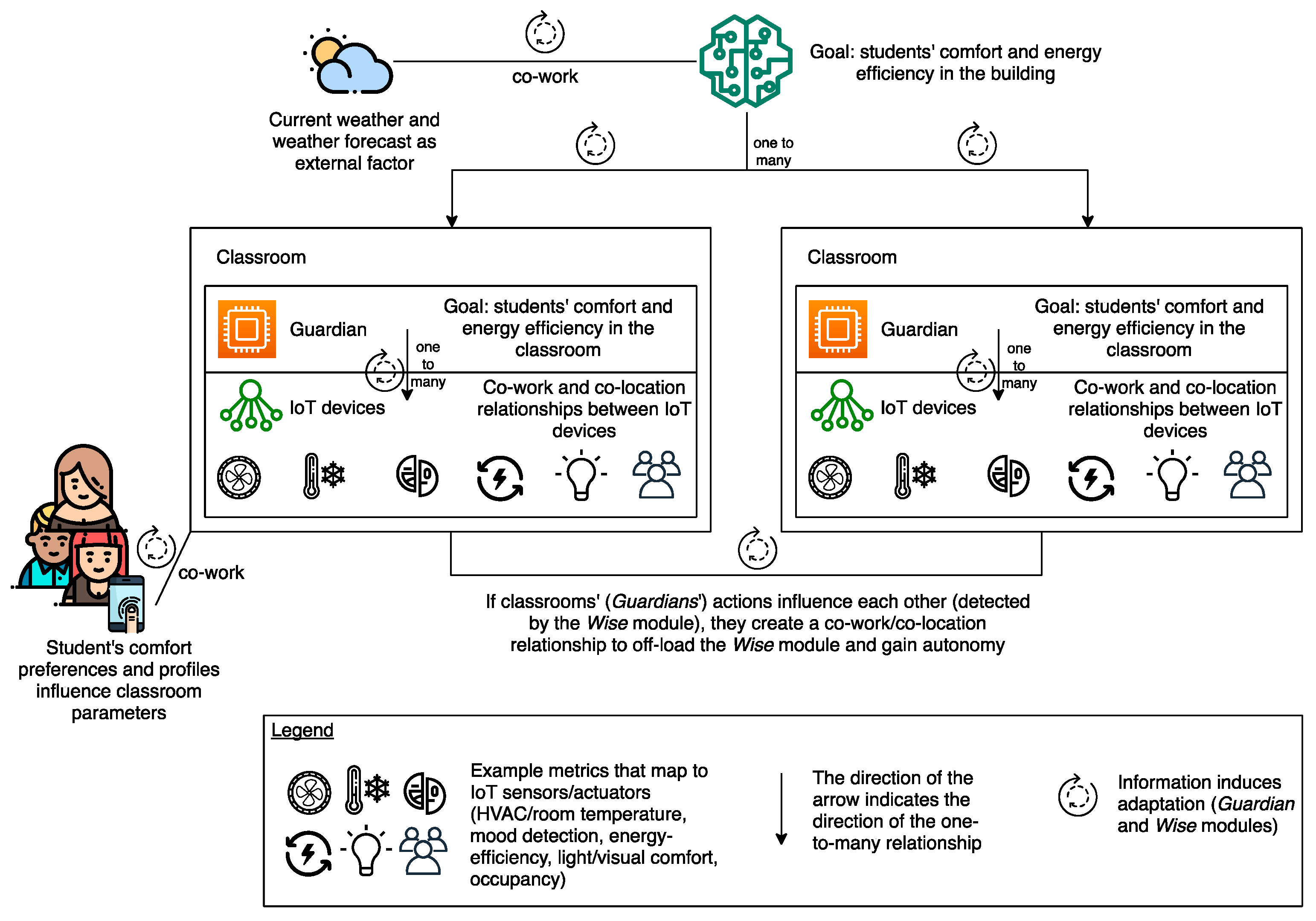
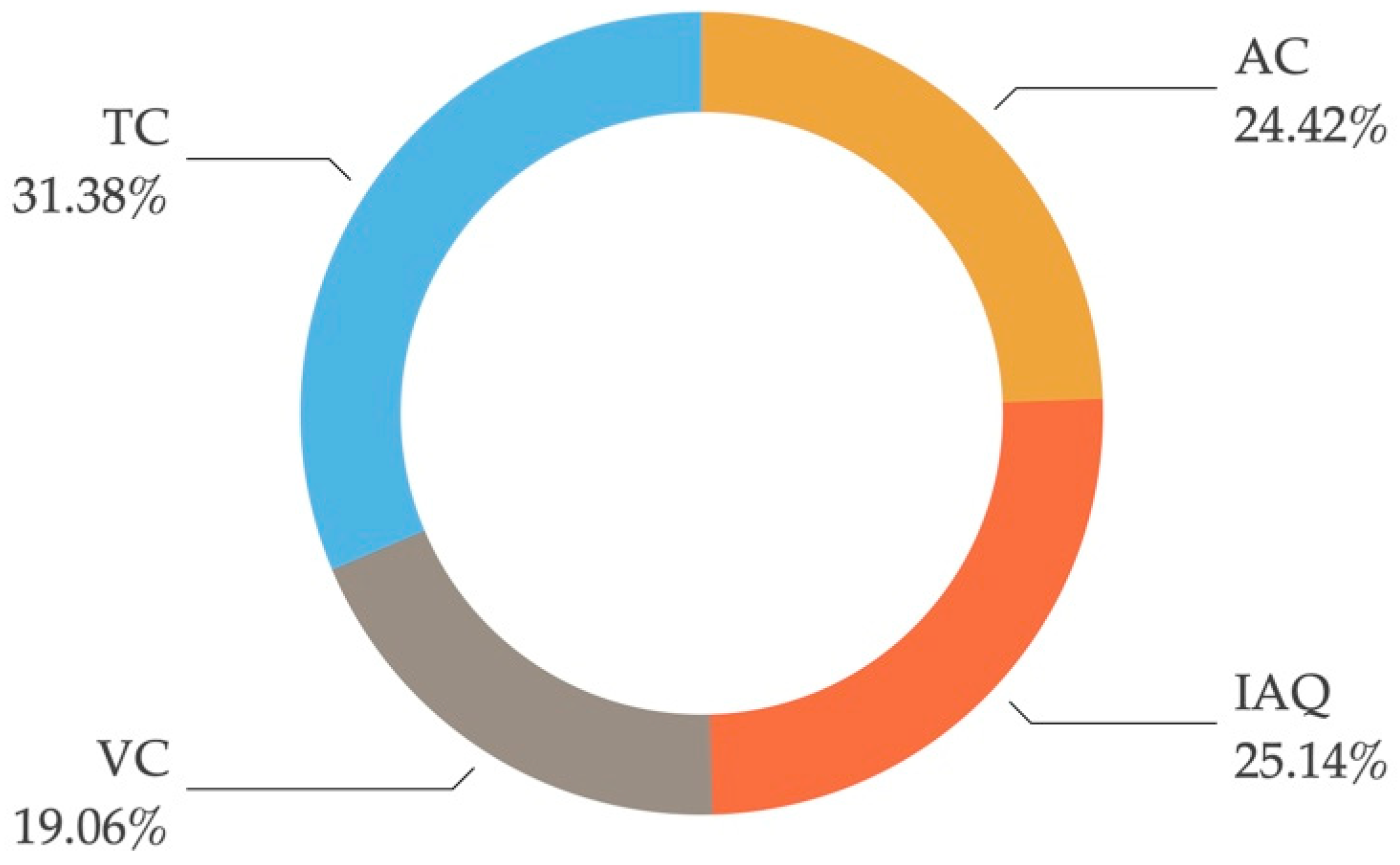
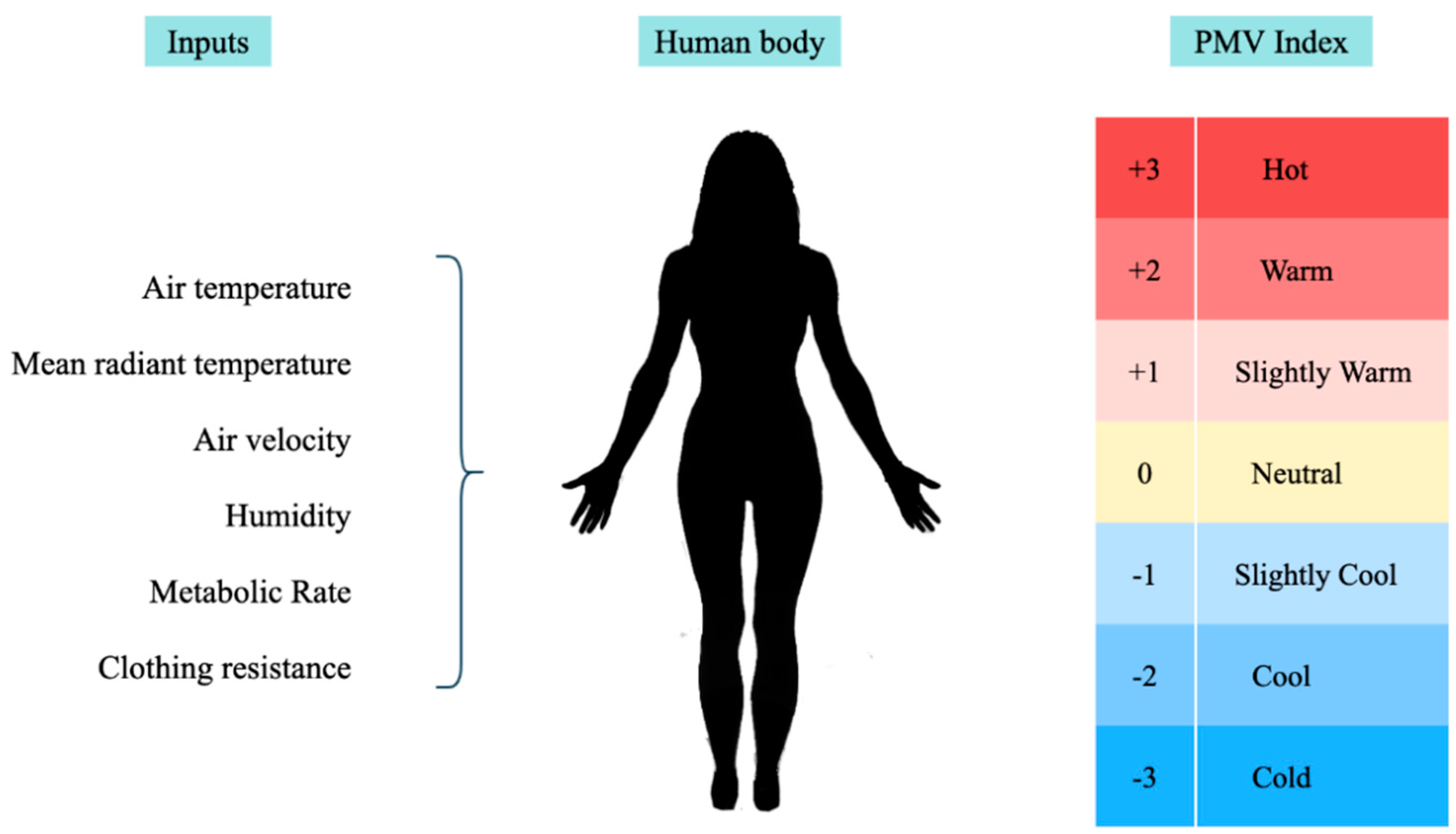


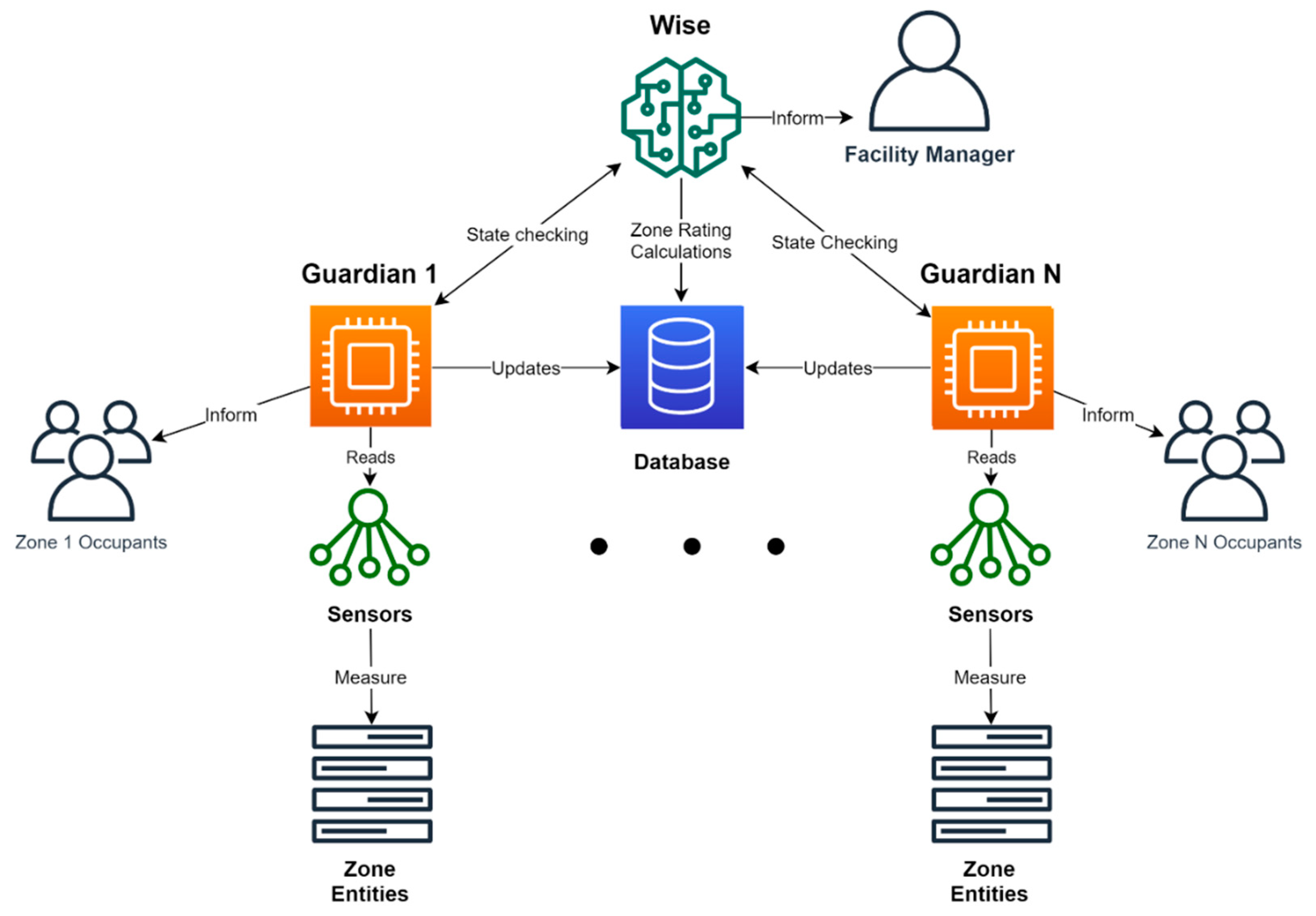
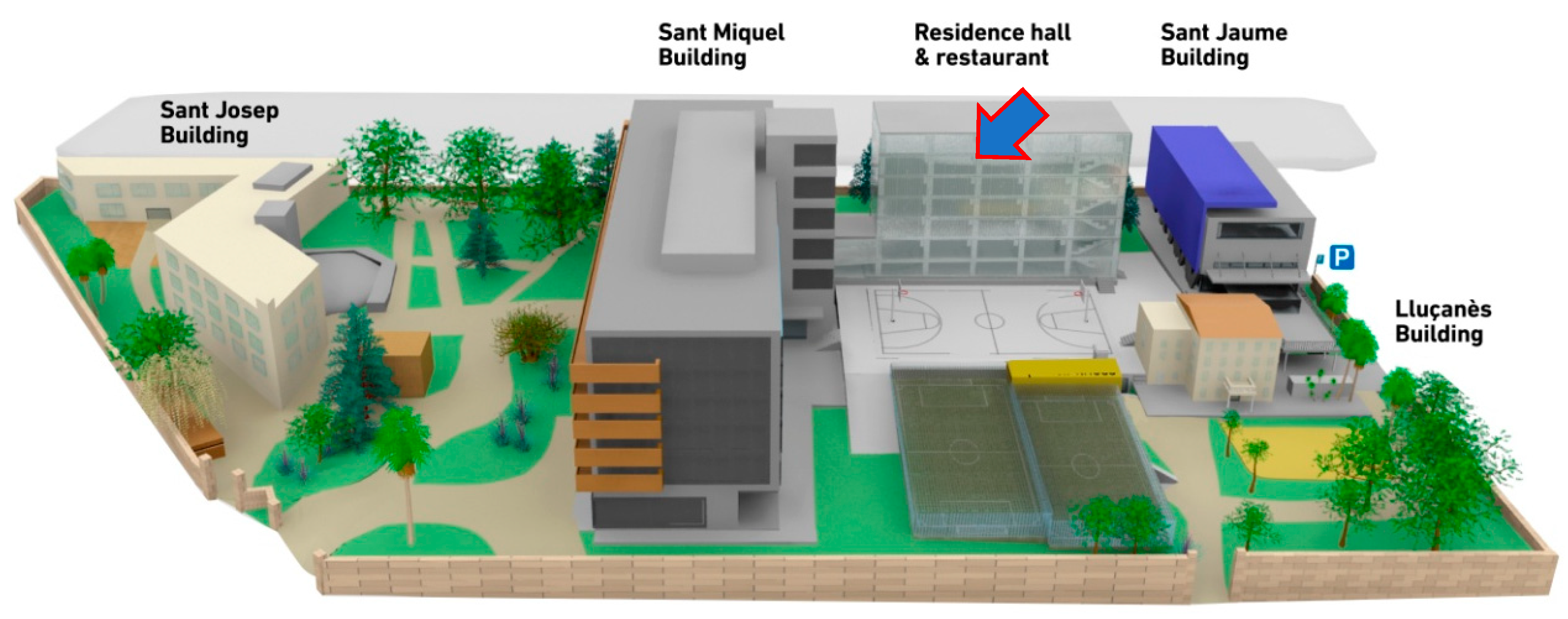
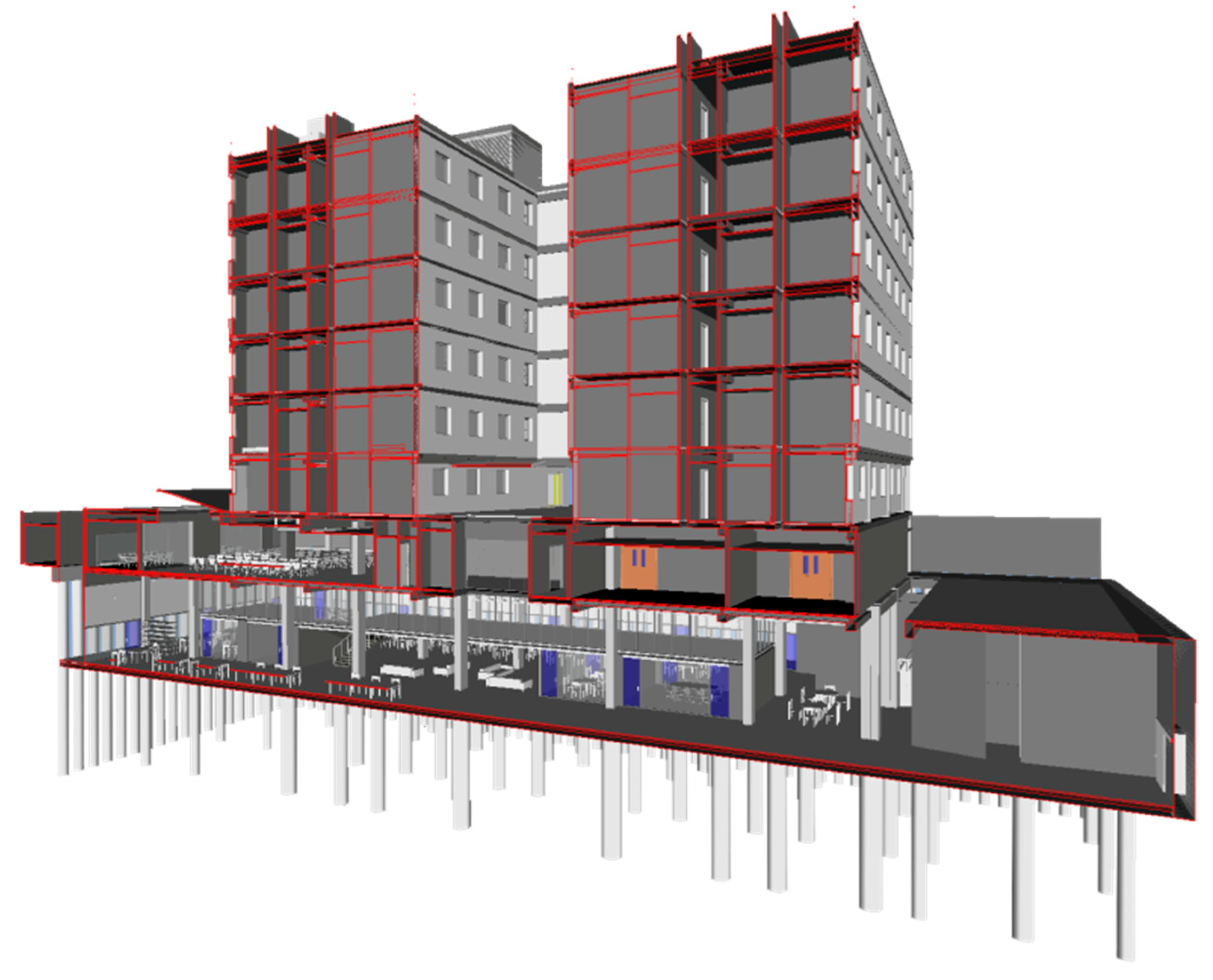

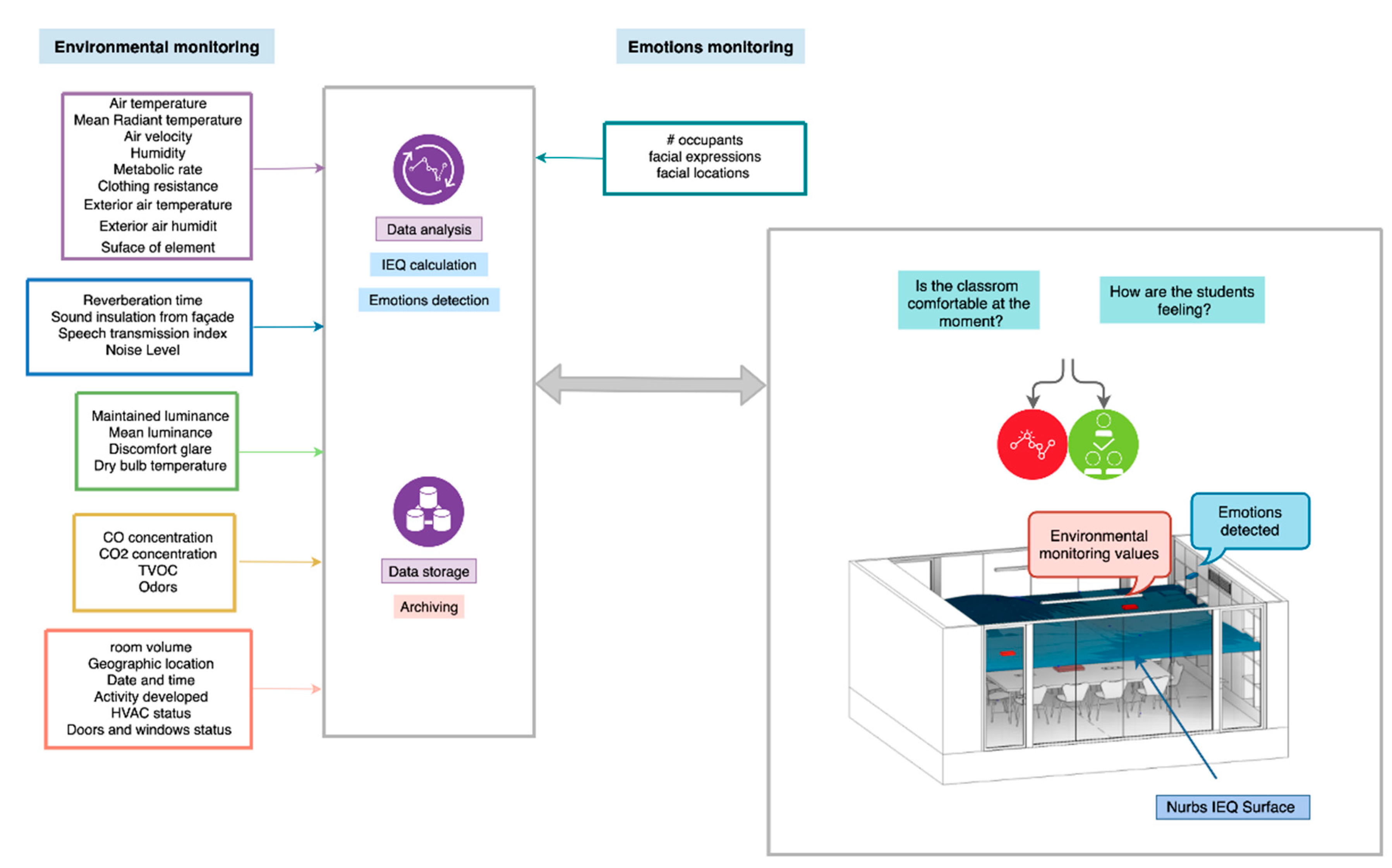
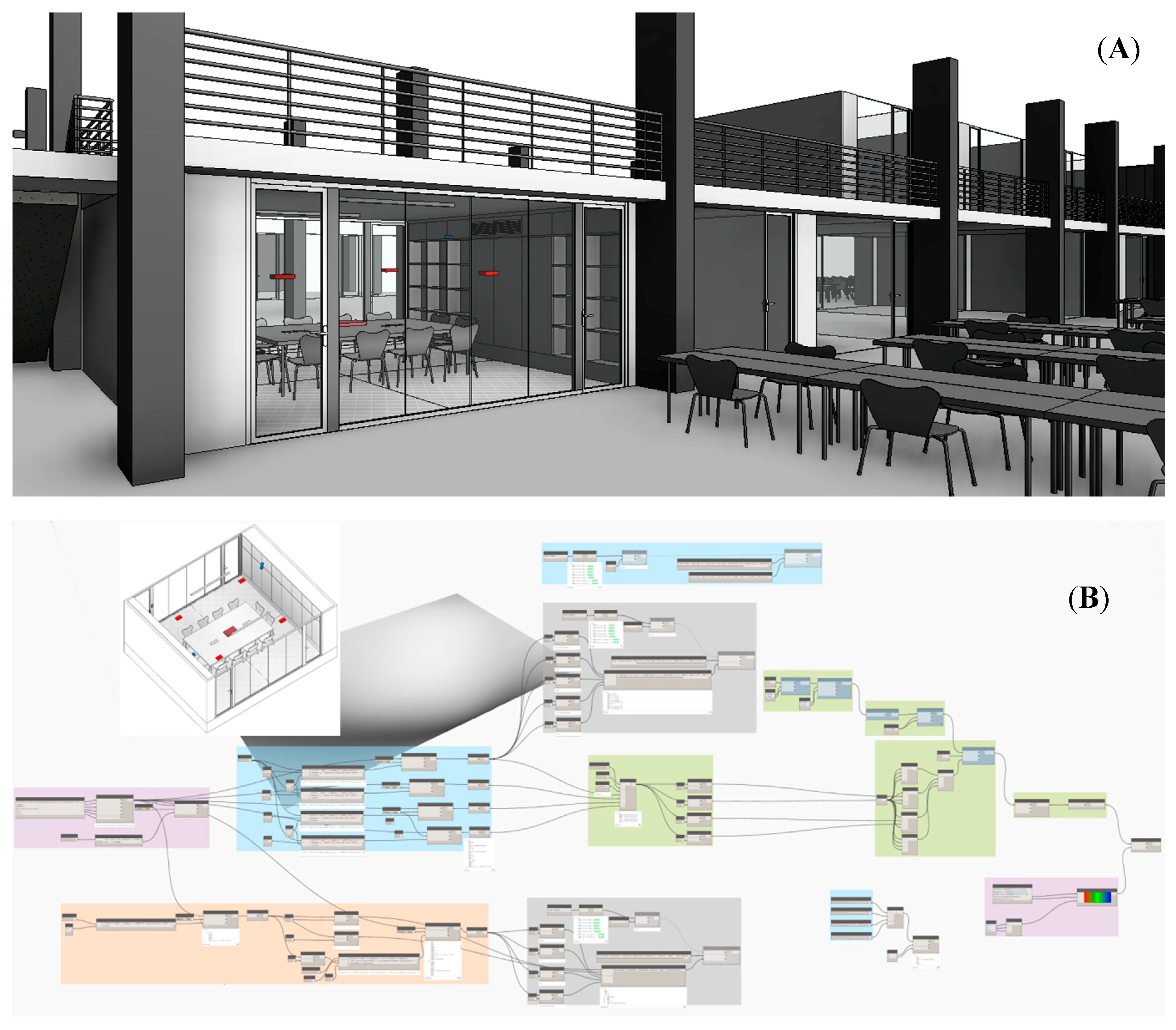
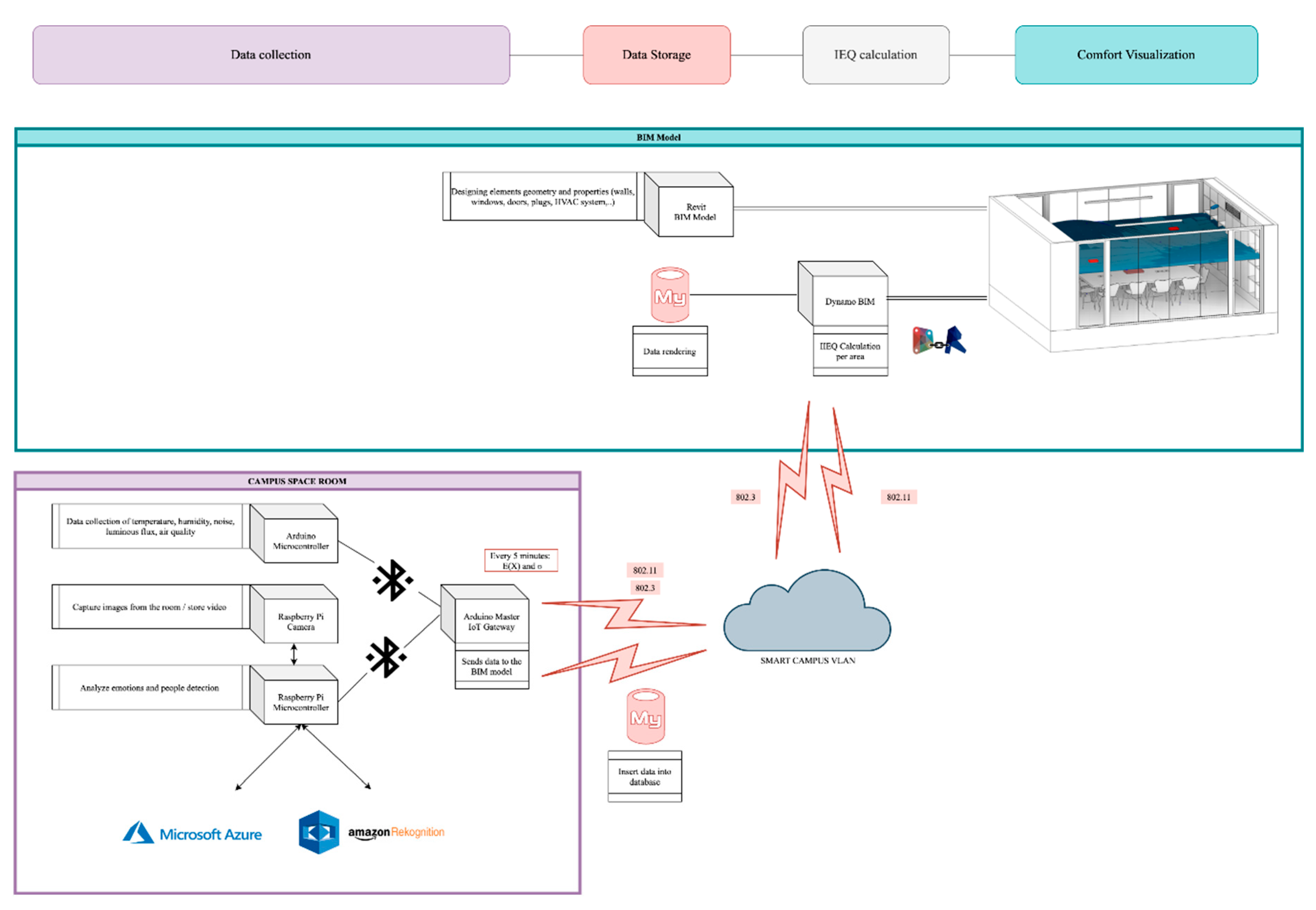

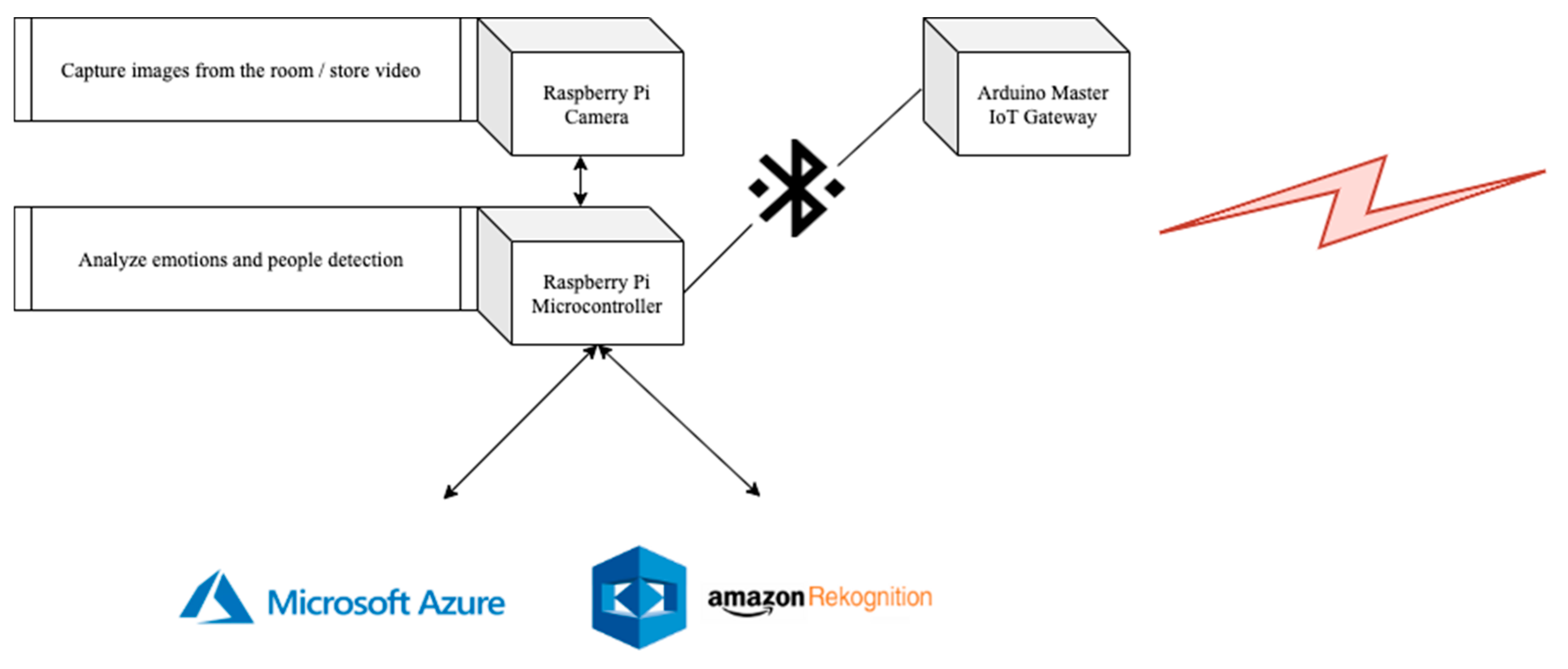

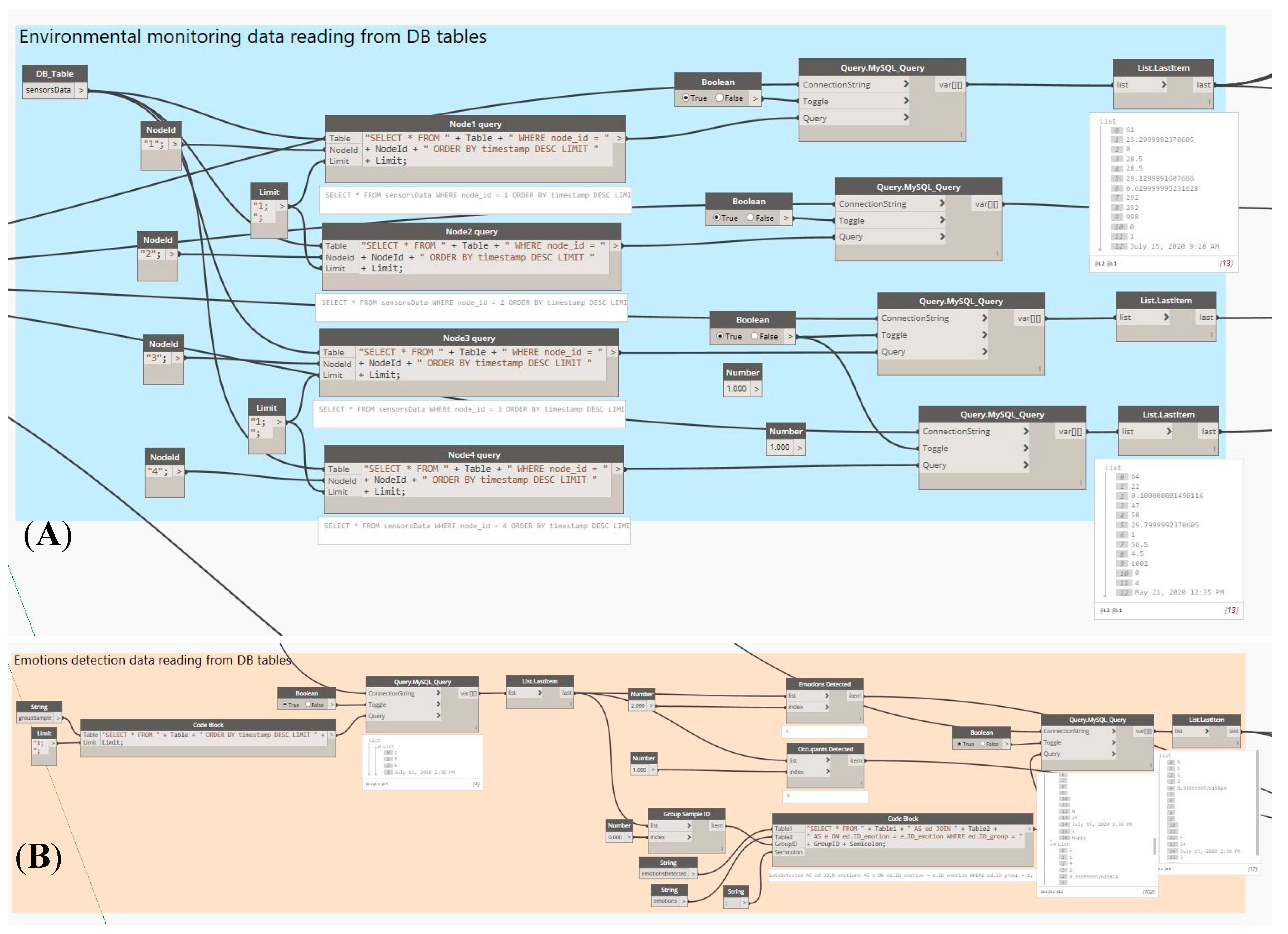

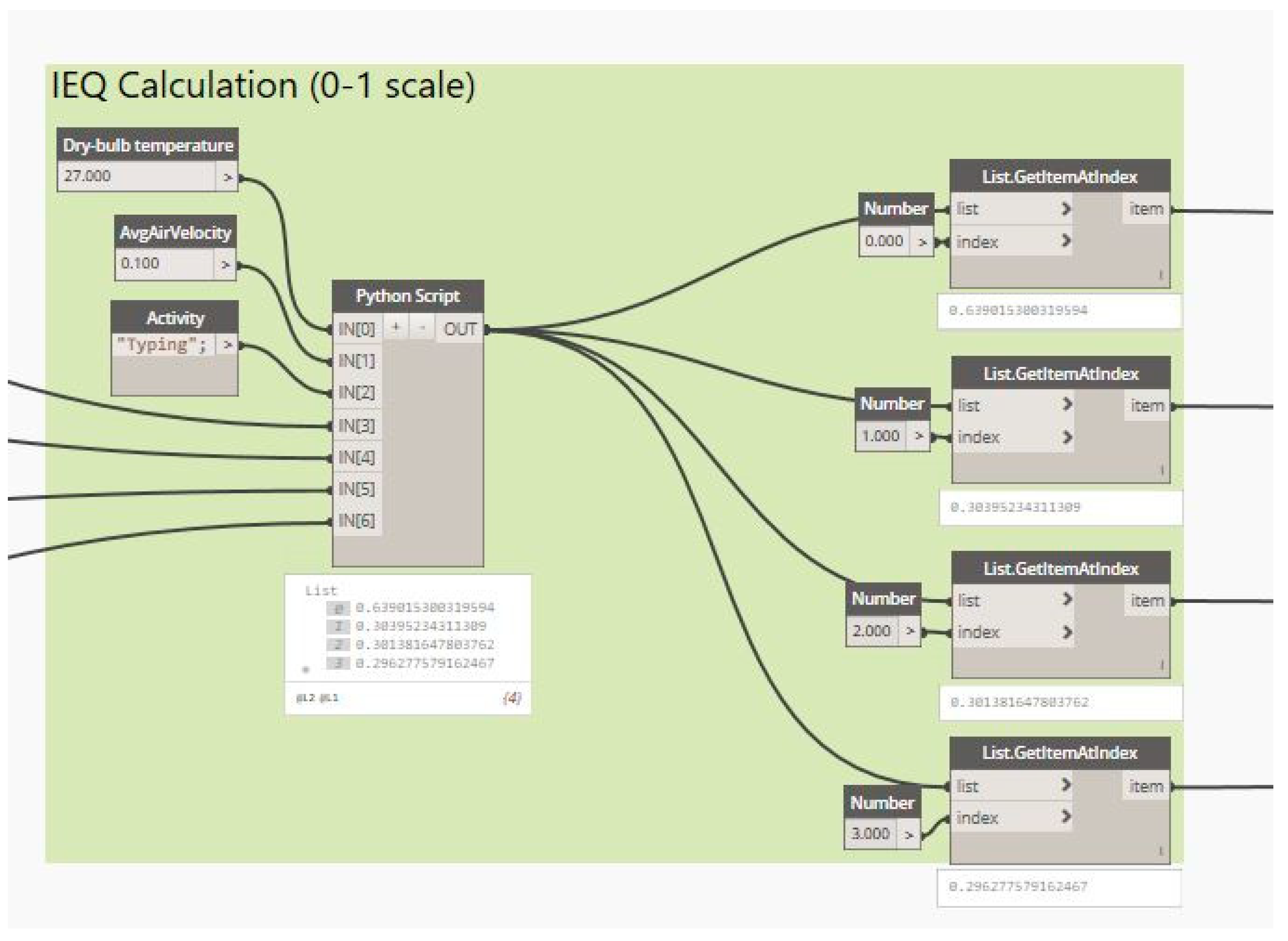
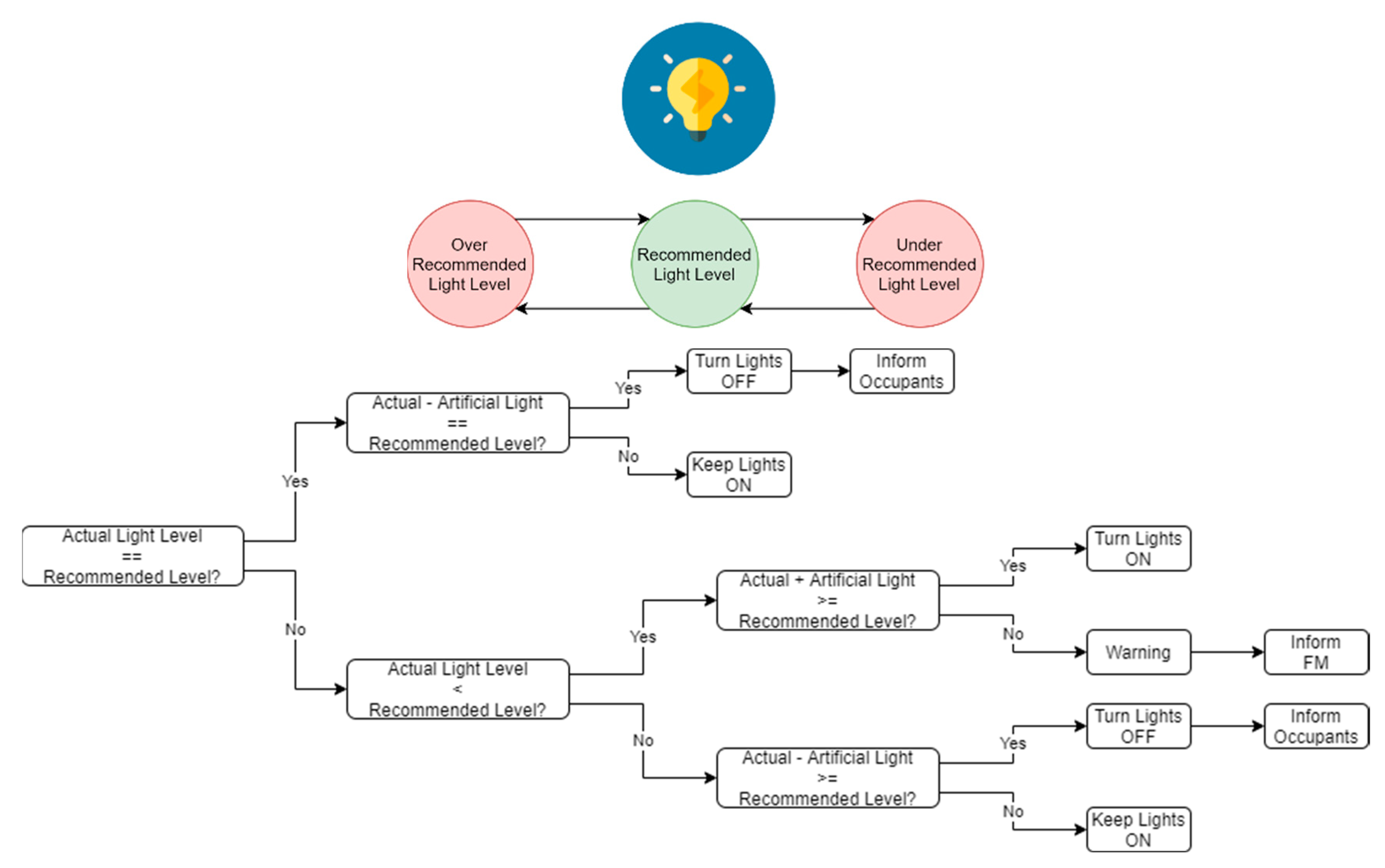


| IoT Middleware | Type | Access Model | Data Format Supported | Programming Language Supported | Protocols | Pricing | Technologies Used |
|---|---|---|---|---|---|---|---|
| AWS IoT Platform | 1 | PaaS, IaaS | JSON | Java, C, NodeJS, Javascript, Python, SDK for Arduino, iOS, Android | HTTP, MQTT, Websockets | Pay when executing your own written functions | All Amazon services |
| Microsoft Azure IoT Hub | 1 | IaaS | JSON | .NET, UWP, Java, C, NodeJS, Ruby, Android, iOS | HTTP, AMQP, MQTT | Pay according to the number of devices and messages per day | Azure Cosmos DB, Azure Tables, SQL database |
| IBM Watson IoT Platform | 1 | PaaS, IaaS | JSON, CSV | C#, C, Python, Java, NodeJS | MQTT | Pay according to the number of devices and messages per day | Cloudant NoSQL DB |
| Google IoT Platform | 4 | PaaS, IaaS | JSON | Go, Java, NET, Node.js, php, Python, Ruby | MQTT, HTTP | Priced per MByte | Google’s services |
| Kaa IoT Platform | 4 | IaaS | JSON | Java, C, C++ | MQTT, CoAP, XMPP, TCP, HTTP | Free | NoSQL, MangoDB, Real time analytics and visualizatoin with Kaa |
| ThingSpeak | 2 | PaaS | JSON, XML | Matlab | MQTT API and REST | Free | Matlab, dashboard and Matlab analytics, MySQL |
| Carriots | 3 | PaaS | XML, JSON | Java | MQTT | Paid services | NoSQL Big- Database |
| Temboo | 3 | PaaS | Excel, CSV, XML, JSON | C, Java, Python, iOS, Android, javascript | HTTP, MQTT, CoAP | Free access for first 100 devices after that paid per device | Microsoft Power BI, Google BigQuery |
| Thinger.io | 2 | PaaS | JSON | HTTP, MQTT | MongoDB | ||
| Sentilo | 3 | PaaS | JSON | C, Java | HTTP | Free | Redis, Apache, PubSub, MongoDB, ElasticSearch |
| Metric | Regression Constants | Calculation |
|---|---|---|
| AC | K0 = 4.74 | |
| IAQ | K1 = 4.88 | |
| VC | K2 = 3.70 | |
| TC | K3 = 6.09 | |
| IEQ | KIEQ = −15.02 |
| Metric | Parameter | Unit | Measurement Method | Tool or Resource |
|---|---|---|---|---|
| TC | Operant Temperature | °C | Temperature-humidity sensor | DHT22 |
| TC | Relative Humidity | % | Temperature-humidity sensor | DHT22 |
| TC | Occupant metabolic rate | Met | Pulsometer | MAX30102 |
| TC | Mean Radiant temperature | °C | Globe thermometer | Blackglobe-L |
| TC | Air temperature | °C | Temperature-humidity sensor | DHT11 |
| TC | Exterior air temperature | °C | Temperature-humidity sensor | DHT22 |
| TC | Exterior air humidity | °C | Temperature-humidity sensor | DHT22 |
| TC | Surface of element (wall, radiators, windows) | m2 | Thermographic camera module | Adafruit AMG8833 8×8 Thermal Camera Sensor for Arduino |
| TC | Person Clothing resistance | clo | Survey/infrared thermography camera | ThermaCAM s45/FLIR TG165-X |
| IAQ | Air velocity | m/s | CFD simulation | Ansys CFX 18.2/Visual-CFD/SolidWorks and AutodeskInventor CFD add-ons |
| IAQ | Specific flow of air introduced | m3/h | CFD simulation | Ansys CFX 18.2/Visual-CFD/SolidWorks and Autodesk Inventor CFD add-ons |
| IAQ | Air change per hour | h-1 | CFD simulation | Ansys CFX 18.2/Visual-CFD/SolidWorks and Autodesk Inventor CFD add-ons |
| - | Room volume | m3 | - | - |
| - | Number of occupants | - | Camera/PIR motion sensors | Sony IMX219 fish eye module for Raspberry/ElectroPeak HC-SR501 PIR sensor |
| IAQ | TVOC | mg/m3 | TVOC and eCO2 gas sensor | Adafruit SGP30 |
| IAQ | CO | ppm | Carbon monoxide sensor | MQ-7 |
| IAQ | CO2 | ppm | Analog CO2 gas sensor | DFRobot/MG-811 |
| IAQ | Dust | μg/m3 | Grove—Dust sensor | PPD42NS |
| IAQ | multi-Gas (NH3, NOx, alcohol, Benzene, smoke) | ppm | Multi-gas sensor detector | MQ-135 |
| IAQ | Odors | ouE/m2 | Electronic nose | zNose 4300 or 7100 model |
| AC | Reverberation time | s | Sound analyzer | Dual-channel Brüel & Kjaer BK 2260 real-time sound analyze |
| AC | Speech transmission index | - | Acoustic simulations | Odeon 9.0 software |
| AC | Level difference index | dB | Acoustic simulations | Odeon 9.0 software |
| AC | Impact sound pressure level | dB | Acoustic simulations | Odeon 9.0 software |
| AC | Clarity | dB | Sound sensor | Sparkfun sound sensor |
| AC | Sound insulation | dB | Dual-channel sound analyzer and an omnidirectional loudspeaker | Dual-channel Brüel & Kjaer BK 2260 real-time sound analyze |
| VC | Maintained luminance | lux | Lux meter | BH1750/PCE-170 |
| VC | Discomfort glare | - | Image luminance measuring device/luminance meter | OP75/TES 137 |
| VC | Daylight | cd/m2 | CAD simulations | Simulink software |
| VC | Dry bulb temperature | °C | Product specifications | - |
| Space or Area | Maintained Luminance | Discomfort Glare | Observations |
|---|---|---|---|
| Classrooms for morning classes | 300 lx | 19 | Lighting should be controllable |
| Classrooms for evening classes and adults education | 500 lx | 19 | - |
| Lecture hall | 500 lx | 19 | Lighting should be controllable |
| Black board | 500 lx | 19 | Prevent specula reflections |
| Practical rooms and laboratories | 500 lx | 19 | - |
| Computer practice rooms | 500 lx | 19 | - |
| Student common rooms and assembly halls | 200 lx | 22 | - |
| Preparation rooms and workshops | 500 lx | 22 | - |
| Technical drawing rooms | 750 lx | 19 | - |
Publisher’s Note: MDPI stays neutral with regard to jurisdictional claims in published maps and institutional affiliations. |
© 2020 by the authors. Licensee MDPI, Basel, Switzerland. This article is an open access article distributed under the terms and conditions of the Creative Commons Attribution (CC BY) license (http://creativecommons.org/licenses/by/4.0/).
Share and Cite
Zaballos, A.; Briones, A.; Massa, A.; Centelles, P.; Caballero, V. A Smart Campus’ Digital Twin for Sustainable Comfort Monitoring. Sustainability 2020, 12, 9196. https://doi.org/10.3390/su12219196
Zaballos A, Briones A, Massa A, Centelles P, Caballero V. A Smart Campus’ Digital Twin for Sustainable Comfort Monitoring. Sustainability. 2020; 12(21):9196. https://doi.org/10.3390/su12219196
Chicago/Turabian StyleZaballos, Agustín, Alan Briones, Alba Massa, Pol Centelles, and Víctor Caballero. 2020. "A Smart Campus’ Digital Twin for Sustainable Comfort Monitoring" Sustainability 12, no. 21: 9196. https://doi.org/10.3390/su12219196
APA StyleZaballos, A., Briones, A., Massa, A., Centelles, P., & Caballero, V. (2020). A Smart Campus’ Digital Twin for Sustainable Comfort Monitoring. Sustainability, 12(21), 9196. https://doi.org/10.3390/su12219196









